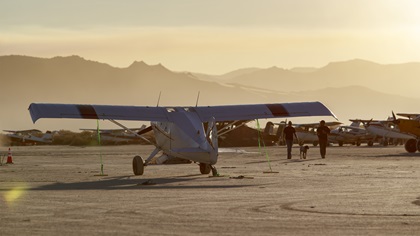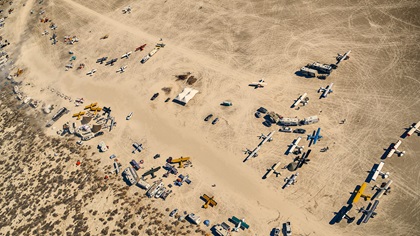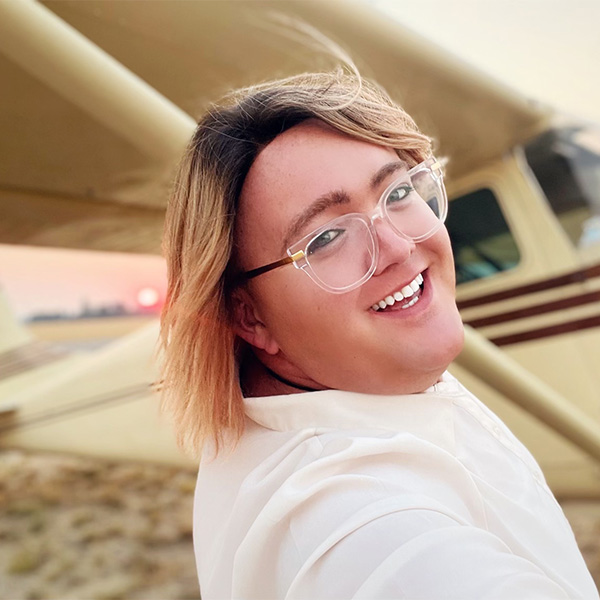Dusty desert checklist
A High Sierra Fly-In how-to
Pilots tend to be take-charge people. The passive among us just don’t make the cut. Carry that energy into preparing for High Sierra Fly-In in Nevada, and you’ll have a great time—if, that is, you relish a truly off-grid camping experience.
Self-reliance and personal responsibility are the keys to having a successful trip. There is no water, electricity, or Wi-Fi, and no other modern amenities are available. There are no showers, but registration fees do cover portable toilets. In recent years, the food truck service has proven increasingly reliable. The general guidance is that you need to pack it in, and pack it out. We leave no trace on this majestic site.
Dressing in layers is key to having a comfortable day. The mornings can dip down into the teens and 20s Fahrenheit. By noon, you’ll be back up into the 70s. Afternoon highs approaching 90 degrees F are not uncommon. You’ll want to be prepared for it all. I usually wear a thermal base layer, followed by a T-shirt, a flannel, and then a light jacket, all with jeans and atop sturdy shoes or boots. By nighttime, it’s cold; you need a heavy jacket. I usually wear my cold-weather hunting gear to the evening fire because it’s the warmest coat I have.
Bring a mask or face covering. The dust, when it gets going in the wind, is suffocating. For personal hygiene, I switched from carting in water for solar camp showers to using disposable cleansing wipes and have had equally marginal results. By the end of it, everyone is dirty. That’s part of the experience. Plan on at least a solid day of cleaning your gear after. You’ll be finding dust in things for months.
This isn’t the Wild West. Safety is the single most important aspect of the High Sierra Fly-In, and the No. 1 focus of event founder Kevin Quinn. The lakebed may seem like an adventurous place, but it simply mustn’t be. This isn’t the place or time to try something new in your airplane. Rules and procedures have been established and are strictly enforced. The lakebed is private property owned by several of the organizers, and they have zero tolerance for reckless or foolish behavior.

High Sierra Fly-In publishes a "STOLTAM” that each pilot is expected to know, follow, and have a copy of on board the aircraft. Pilots communicate on 121.05 MHz (previously 122.72 MHz). Land and depart at your own risk, but follow procedures published in the "STOLTAM." The lakebed is right traffic only. (Repeating: Right traffic only.) Takeoffs and landings should only happen on the designated runways. All engines should be shut down before approaching the portable toilet line. You won’t have a problem finding people to help you push your airplane to and from the operations area.
There was a fatal midair collision in 2014 at a previous location of the event. A pilot did not use the established runway, climbed into the downwind, and impacted another airplane–killing the pilots of both aircraft. With the rapid growth of the event in recent years, the focus is on preventing another accident. Adherence to the STOLTAM procedures and the event's safety culture will grant you access to some of the most beautiful, fun, and social flying of your life.
There are many beautiful places to fly within a few minutes of Dead Cow. Just around the ridgeline to the east is Pyramid Lake, on the edge of which you can fly through the steam of an active geyser. A few minutes to the north is the Black Rock Desert, site of Burning Man. There are geothermal hot pots in the surrounding area where you can land and soak in a natural mineral bath. Lake Tahoe is nearby. Pilots are continuously forming impromptu fly-outs to these wonders. Don’t have an airplane? Somebody is bound to offer you a seat. Just get to know the folks you encounter, and you’ll be an instant part of the community.
There is no fuel available at the event, for your airplane or other internal combustion devices. The nearest fuel is roughly 30 nautical miles to the northwest at Susanville Municipal Airport in California. You’ll have reasonable cell service on the lakebed, depending on your carrier. I always bring a portable cellphone repeater and have fabricated a custom mast to elevate the antenna. The food trucks take cards but bring cash. Bring sunscreen and a portable camp chair. Leave all glass bottles at home. I’ve always tent camped, but there are virtues to having an RV on site. If you do tent-it, I wouldn’t bring less than a 0-degree-F-rated sleeping bag. Thermal separation from the ground is essential. I prefer an air mattress.

Driving directions are available on the High Sierra Fly-In website, but the event is made for flying in. You will not find smooth paved roads lined with gas stations leading to Dead Cow Lakebed.
This party in the desert is just that—a party. The campfire keeps people going well into the night. It's rowdy, but wholesome. Many people bring their kids. That said, if you are an early-to-bed type, select a campsite farther away from the fire. People have fun here—loud fun—and it lasts until the wee hours.
The culture of the event is unique. It is not “Burning Man with airplanes,” so much as it is an intentional community built out of the dry lakebed once a year. People from all walks of life, with various backgrounds, interests, and skill levels, show up from all over the world to celebrate a common love for backcountry aviation. You’ll see acts of “playa magic,” where folks will go out of their way to serve others. One couple provides morning coffee and keeps supplies and snacks to hand out—just because. A well-known aircraft mechanic brings his entire toolkit to the lakebed to help anyone in need, free of charge. An area rancher who runs a lumber mill provides thousands of pounds of discarded timber for the nightly bonfire. The examples of that community-minded spirit could go on for pages.
Simply put, people are there because we want to be—and newcomers are welcome. Go in prepared to support and provide for yourself for a few days, and don’t be surprised when your fellow attendees step in to help you have a better time. When you’re able, pay it forward. That’s the spirit of the High Sierra Fly-In. See you at Dead Cow.








